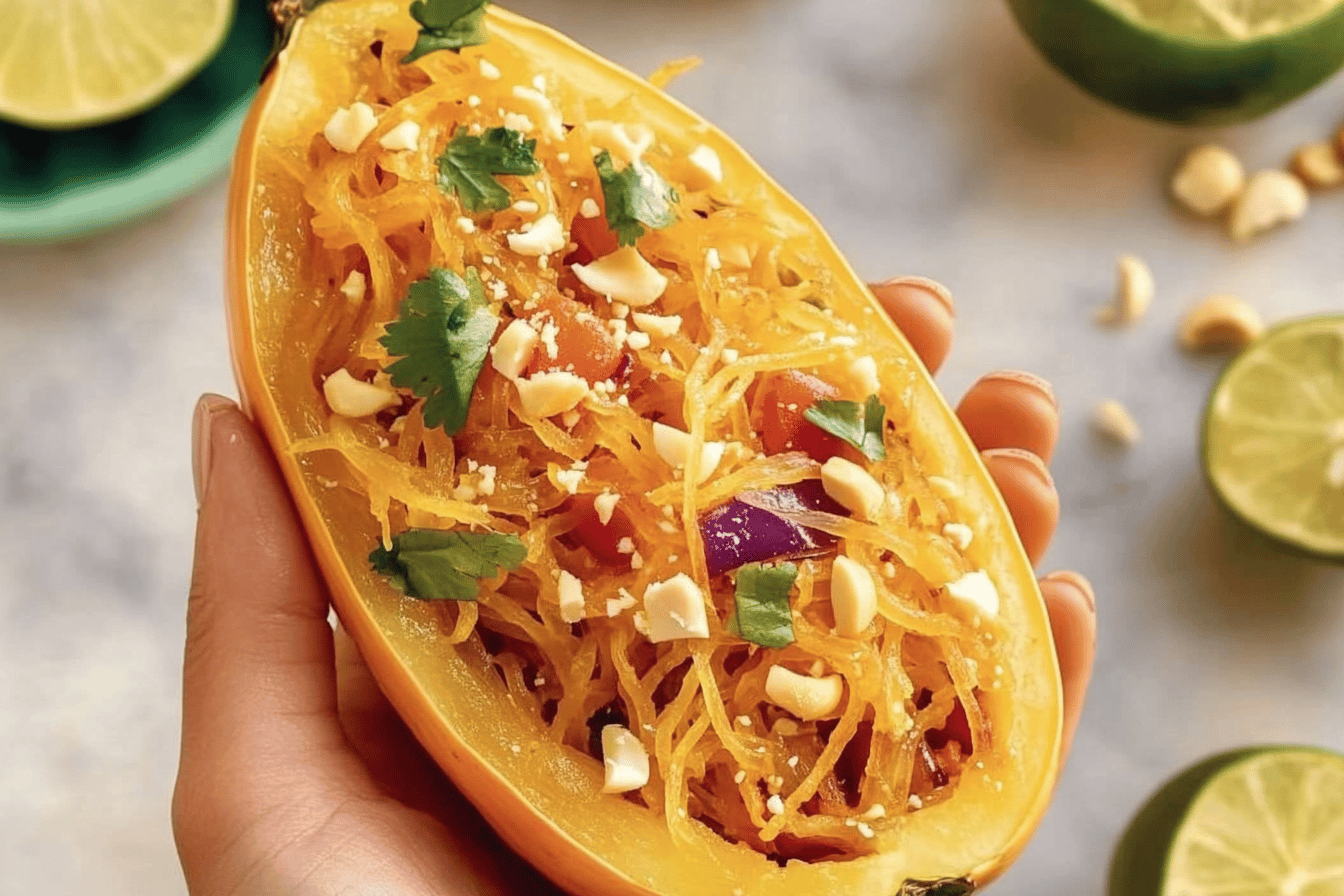Pad Thai is a beloved Thai dish known for its tantalizing flavors and satisfying texture. Traditionally made with rice noodles, this version takes a delightful twist by incorporating spaghetti squash, making it a healthier alternative without sacrificing taste. This Spaghetti Squash Pad Thai embraces the essence of the classic dish while catering to those seeking a lighter meal option. Perfect for weeknight dinners or meal prep, this dish offers a balance of nutrients and flavors, making it suitable for various occasions, from casual family meals to sophisticated gatherings. The vibrant colors and textures of the vegetables enhance its appeal, and the sauce provides a deliciously tangy and sweet finish.
Tools and Equipment
Before you embark on this culinary adventure, gathering the right tools and equipment will ensure a seamless cooking experience. Here’s what you will need:
- Cutting board
- Sharp knife
- Baking sheet
- Mixing bowl
- Whisk
- Fork
- Measuring cups and spoons
- Serving dish
These tools will help you efficiently prepare and serve your Spaghetti Squash Pad Thai.
Ingredients List
To create this delicious dish, you’ll need the following ingredients:
- 1 medium spaghetti squash
- 1 cup shredded carrots
- 1 cup bean sprouts
- 2 green onions, sliced
- 1/4 cup chopped peanuts
- 3 tablespoons soy sauce
- 1 tablespoon maple syrup
- 1 tablespoon peanut butter
- Juice of 1 lime
Each ingredient plays a vital role in the overall flavor and texture of the dish:
Spaghetti squash: This serves as the base of your Pad Thai, providing a light and nutritious alternative to traditional noodles. Its unique texture mimics spaghetti and absorbs the flavors of the sauce beautifully.
Shredded carrots: These add a sweet crunch, enhancing the dish’s texture while contributing vitamins and minerals.
Bean sprouts: They offer a fresh, crisp bite and are a classic ingredient in authentic Pad Thai.
Green onions: These provide a mild onion flavor and a pop of color, making the dish visually appealing.
Chopped peanuts: These are essential for that signature nutty flavor and crunchy texture that complements the softness of the squash and vegetables.
Soy sauce: This adds a savory umami depth to the dish.
Maple syrup: A natural sweetener that balances the saltiness of the soy sauce.
Peanut butter: It enriches the sauce with creaminess and enhances the peanut flavor.
Lime juice: This brightens the dish with acidity, balancing the flavors harmoniously.
Preparation Steps
Before you start cooking, it’s essential to prepare your ingredients to ensure a smooth cooking process. Follow these steps:
- Preheat your oven to 400°F (200°C) to prepare for roasting the spaghetti squash.
- Carefully cut the spaghetti squash in half lengthwise using a sharp knife. Be cautious as the squash can be tough to cut.
- Scoop out the seeds from each half using a spoon.
- Place the squash halves cut side down on a baking sheet. This will help to roast them evenly.
- Roast the squash in the preheated oven for about 40 minutes, or until the flesh is tender and easily scraped with a fork.
While the squash roasts, you can prepare the sauce and chop the vegetables to save time.
Step-by-Step Cooking Instructions
Now that your spaghetti squash is roasted and your ingredients are prepped, follow these steps to create your Spaghetti Squash Pad Thai:
- In a medium bowl, whisk together the soy sauce, maple syrup, peanut butter, and lime juice until smooth. This will create a delicious sauce that brings all the flavors together.
- Once the spaghetti squash is done roasting, remove it from the oven and let it cool slightly.
- Using a fork, scrape the flesh of the squash to create strands and transfer them to a large mixing bowl.
- Add the shredded carrots, bean sprouts, and sliced green onions to the bowl with the squash.
- Pour the prepared sauce over the squash and vegetables. Toss everything together until well combined, ensuring that the sauce coats all the ingredients.
- Serve the dish topped with chopped peanuts for added crunch and flavor.
Tip: For an extra burst of flavor, consider garnishing with additional lime wedges and fresh cilantro before serving.
Nutritional Information and Health Benefits
This Spaghetti Squash Pad Thai is not only delicious but also packed with nutrients. Here’s a closer look at its nutritional value:
- Low in calories: Spaghetti squash is a low-calorie alternative to pasta, making this dish a great choice for those watching their weight.
- Rich in vitamins: Carrots and bean sprouts are loaded with vitamins A and C, contributing to overall health and immunity.
- High in fiber: The vegetables and squash provide dietary fiber, promoting digestive health.
- Plant-based protein: The peanuts and peanut butter offer healthy fats and protein, making this dish satisfying and energizing.
Health benefits: Incorporating more vegetables into your diet can help reduce the risk of chronic diseases, promote heart health, and support weight management. This dish is a testament to how you can enjoy a classic favorite while prioritizing your health.
Common Mistakes and Tips to Perfect the Recipe
Even the best recipes can have a few pitfalls. Here are some common mistakes to avoid and tips for perfecting your Spaghetti Squash Pad Thai:
- Not roasting the squash long enough: Ensure the squash is tender before scraping. Undercooked squash will be crunchy and hard to eat.
- Overcooking the vegetables: Add the vegetables to the bowl after the squash is cooked to maintain their freshness and crunch.
- Skipping the sauce whisking: Make sure to whisk the sauce thoroughly to combine the peanut butter without lumps.
- Not adjusting seasoning: Taste the dish before serving and adjust with more lime juice or soy sauce if necessary.
Advanced Tip: For added protein, consider incorporating tofu or shrimp. Cook them separately and mix them in before serving for a heartier meal.
Storage, Serving, and Reheating Tips
Once you’ve enjoyed your delicious Spaghetti Squash Pad Thai, you may have leftovers. Here’s how to store and serve them:
- Storage: Store any leftovers in an airtight container in the refrigerator for up to 3 days.
- Freezing: While it’s best enjoyed fresh, you can freeze the dish for up to a month. However, the texture of the vegetables may change upon thawing.
- Reheating: Reheat in the microwave or on a stovetop, adding a splash of water or extra lime juice to revive the flavors.
Serving suggestion: Pair your Pad Thai with a side of fresh cucumber salad or a light soup for a complete meal that balances flavors and textures.
FAQs and Recipe Variations
Here are some frequently asked questions about making Spaghetti Squash Pad Thai, along with variations to try:
Can I use regular pasta instead of spaghetti squash?
Yes, you can substitute with rice noodles or any pasta of your choice, but it will change the nutritional profile of the dish.
Is this recipe gluten-free?
Yes, as long as you use gluten-free soy sauce, this dish is perfect for those with gluten sensitivities.
Can I add protein to this dish?
Absolutely! You can add tofu, chicken, or shrimp for extra protein.
Recipe Variations:
- Add bell peppers or broccoli for additional vegetables.
- Include scrambled eggs for a traditional touch.
- Spice it up with some red pepper flakes or sriracha for heat.
- Substitute almond butter for peanut butter if you have nut allergies.
Conclusion
The Spaghetti Squash Pad Thai offers a unique and healthy twist on a classic dish, proving that you can enjoy flavorful meals while maintaining a nutritious diet. Its versatility and ease of preparation make it a fantastic choice for any day of the week. So gather your ingredients, follow the steps, and savor every bite of this vibrant, wholesome dish. Remember, cooking is all about experimenting and enjoying the process, so don’t hesitate to make it your own!

